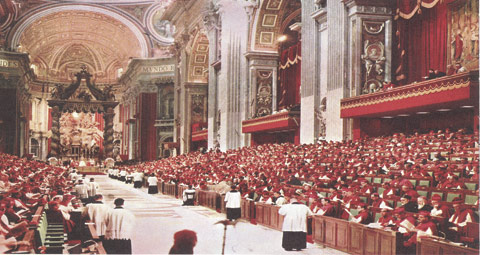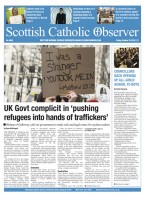August 4 | ![]() 0 COMMENTS
0 COMMENTS ![]() print
print

Council set to right the wrongs of Faith forgeries
MGR BASIL LOFTUS
WHICH way should we face at Mass in church—East or West? And should the priest and people all face the same way, or should the priest face the people? I suppose it’s all been clear to me since I was ten years old.
In 1945 Britain was very slowly emerging from wartime gloom. The Windmill Theatre in London may well have remained open all through the war, but children’s pantomimes in Yorkshire did not. So the first time I went to the theatre was just after the war, at the age of ten. The charabanc which took us there from school was a rather gloomy experience. Behind the driver’s head was a large sign—‘Do not talk to the driver.’ So we silently studied the back of his head.
But once in the theatre everything was so different. We were all obviously a bit at sea—nothing like this had featured in our young lives before. Fortunately the whole affair was brilliantly directed by a true thespian. Before the curtain rose he wandered amongst us and involved us all in the entire production we were about to see. We practised the ditties and learned when to shout ‘behind you.’
So when 20 years later our church buildings stopped looking like buses, with passive passengers sitting behind the priest-driver, looking at the back of his head, and not being allowed to talk—when instead they started to look more like ‘theatres in the round,’ I began to look for the ‘warm-up’ man who would involve us and lead us through the singing and actions. Nor was I disappointed. Vatican II’s Constitution on the Sacred Liturgy—Sacrosanctum Concilium—was quite clear: “By way of promoting active participation, the people should be encouraged to take part by means of acclamations, responses, psalmody, antiphons, and songs, as well as by actions, gestures, and bodily attitudes. And at proper times all should observe a reverent silence” (n.30).
Two years after the end of the Council, on 25 May 1967, the Sacred Congregation of Rites issued its Instruction, Eucharisticum Mysterium. This stressed the need for everyone at Mass to be united not only with the priest, but with one another—‘a sense of community should be encouraged’ (n18). “The church should therefore be suitable for the ceremonies, and such as to encourage the people to take their full part” (n253).
So no more sitting silently behind the driver—rather a whole-hearted participation, a ‘sense of community,’ people looking at one another and talking to one another, ‘bodily gestures,’ ‘processions,’ and ‘signs of peace.’
But just how were the churches to be adapted and made ‘suitable for the ceremonies?’
Two essential factors date from the earliest years of the Church—the celebrant always faced the people, and it didn’t matter who faced East or West.
Strangely enough we know this from fakes and forgeries. Towards the end of the fourth century everyone wanted to invoke the authority of the Apostles. But the Apostles had in fact decided very little. So some crook forged in Greek a tome called ‘The Catholic Doctrine of the 12 Apostles and the Holy Disciples of Our Lord,’ and backdated it three and a half centuries to 55AD.
Shortened, understandably, to the simpler title of Didascalia, this book purported to date from Apostolic times, and was later incorporated into yet another forgery called ‘The Apostolic Constitutions.’ The whole eight volumes claimed to have been written by Peter’s immediate successor as Pope, Clement, and set out a vast array of Church practices, laws and teaching, including the rules of Church architecture.
Although it is a fourth century fake, and proves nothing of what happened in Apostolic times, this work does prove what was happening in the fourth century. It gives details of how people worshipped then, when the book was forged.
Relics of the earliest known church, built at Tyre between 313 and 332 AD, show that at that time the celebrant had faced West, and the people faced East. But when the Emperor Constantine started to build churches some decades later he was fooled by the forged Apostolic Constitutions, and in obedience to them had all churches built with the people facing West, and the celebrant facing East.
Which way they faced didn’t matter, but they had always faced one another. This is what Vatican II set out to recapture in its document on Liturgical reform. And that was most decidedly not a forgery.
—Mgr Basil Loftus is a priest of the Diocese of Leeds now living in retirement in the North of Sutherland. He worked in secretariat for English and Welsh bishops in Rome during the Second Vatican Council










